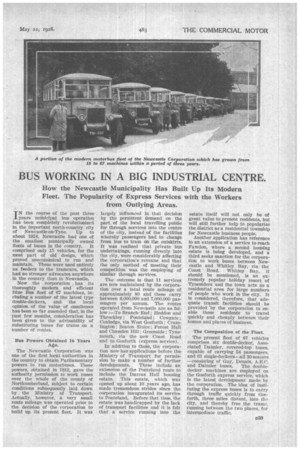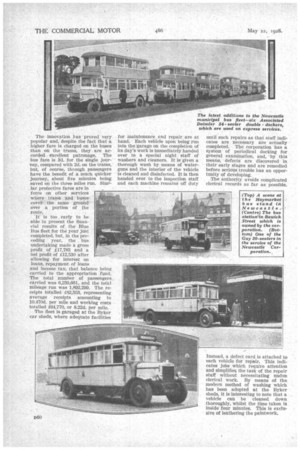BUS WORKING IN A BIG INDUSTRIAL CENTRE.
Page 133

Page 134

If you've noticed an error in this article please click here to report it so we can fix it.
How the Newcastle Municipality Has Built Up Its Modern Fleet. The Popularity of Express Services with the Workers from Outlying Areas.
TN the course of the past three 'years municipal bus operation has been completely revolutionized in the important north-country city of Newcastle-on-Tyne. Up• to about 1924, Newcastle had one of the smallest municipally owned fleets of buses in the country. It comprised only 15 vehicles, for the most part of old design, which proved uneconomical to run and maintain. These were used entirely as feeders to the tramcars, which had no stronger advocates anywhere in the country than in Newcastle.
Now . the corporation has its thoroughly modern and efficient Blue Bus fleet of 67 machines, including a number of the latest type double-deckers, and the local opinion of the value of omnibuses has been so far amended that, in the past few months, consideration has been given to the advisability of substituting buses for trams on a number of routes.
Bus Powers Obtained 16 Years Ago.
The Newcastle Corporation was one of the first local authorities in the country to obtain Parliamentary powers to run motorbuses. These powers, obtained in 1912, gave the authority permission to work buses over the whole of the county of Northumberland, subject to certain conditions subsequently laid down , the Ministry of Transport. Actually, however, a very small route mileage was operated prior to the decision of the corporation to build up its present fleet. It was largely influenced in that decision by the persiStent demand on the part of the local travelling public for through services into the centre of the city, instead of the facilities whereby passengers had to change from bus to tram on tile outskirts. It was realized that private bus undertakings, running directly into the city, were considerably affecting the corporation's revenue and that the only method of meeting their competition was the employing of similar through services.
The outcome is that 11 services are now maintained by the corporation over a total route mileage of approximately 80 and these carry between 6,000,000 and 7,000,000 passengers per annum. The routes operated from Newcastle are as follow :—To Branch End ; Heddon and Throckley; Ponteland ; Cowgate; Coxlocige, via West Gosforth ; Cramlington ; Seaton Sluice ; Forest Hall and Clousden Hill; Greenside; Tynemouth, via the new Coast Road and to Gosforth (express service).
In addition to these, the corporation now has applications before the Ministry of Transport for permission to make a number of further developments. These include an ektension of the Ponteland route to include the Darras Hall housing estate. This estate, which was opened up about 10 years ago, has made tremendous strides since the corporation inaugurated its service to Ponteland. Before that time, the estate was handicapped by the lack of transport facilities and it is felt that a service running into the estate itself will not only be of great value to present residents, but will still further help to popularize the district as a residential township for Newcastle business people.
Another application has reference to an extension of a service to reach Fawdon, where a second housing estate is being developed, and a third seeks sanction for the corporation to work buses between Newcastle and Whitley Bay, via the Coast Road. Whitley Bay, it should be mentioned, is an extremely popular holiday resort of Tyne.siders and the town acts as a residential area for large numbers of people who work in the city. It is considered, therefore, that adequate transit facilities should be provided 'by the corporation to enable these residents to travel quickly and cheaply between their homes and places of business.
The Composition of the Fleet.
The present fleet of 67 vehicles comprises six double-decker, Associated Daimler, covered-top buses, capable of carrying 54 passengers, and 61 single-deckers—all 30-seaters —consisting of Guy, Dennis, A.E.C. and Daimler buses. The doubledecker machines are employed on the Gosforth express service, which is the latest development made by the corporation. The idea of instituting the express buses is to carry through traffic quickly from Gosforth, three miles distant, into tho city, and thereby free the trains, running between the two places, for intermediate traffic. The innovation has proved very popular and, despite the fact that a higher fare is charged on the buses than on the trams, they are accorded 4xcellent patronage. The bus fare is 3d. for the single journey, compared with 2d. on the trams, but, of course, through passengers have the benefit a a much quicker journey, about five minutes being saved on the three miles run. Similar protective fares are in force on other services where • ttamb and buses cover' the same ground over a portion of the
route. , It is too . early to be able to present the financial results of the Blue Bus fleet for the year just completed, but, in the preceding year, the has undertaking made a gross profit of £17,783 and a net profit of 112,530 after allowing for interest on loans, repayment of loans and income tax, that balance being carried to the appropriation fund. The total number of passengers carried was 6,239,661, and the total mileage run was 1,892,299. The receipts totalled £82,553, representing average receipts amounting to 10.470d. per mile and working costs totalled £64,770, or 8.22d. per mile.
The fleet is garaged at the Byker car sheds, where adequate facilities for maintenance and repair are at hand. Each vehicle upon being run into the garage on the completion of its day's work is immediately handed over to a special night staff of washers and cleaners. It is given a thorough wash by means of waterguns and the interior of the vehicle is cleaned and disinfected. It is then handed over to the inspection staff and each machine remains off duty until such repairs as that staff indicates are necessary are actually completed. The corporation has a system of periodical docking for general examination, and, by this means, defects are discovered in their early stages and are remedied before serious trouble has an opportunity of developing. .The authority avoids complicated clerical records as far as possible.
Instead, a defect card is attached to each vehicle for repair. This indicates jobs which require attention and simplifies the task of the repair staff without necessitating undue clerical work. By means of the modern method of washing which has been adopted at the Byker sheds, it is interesting to note that a vehicle can be cleaned down thoroughly, whilst the time taken is inside four minutes. This is exclusive of leathering the paintwork.




















































































































































































































